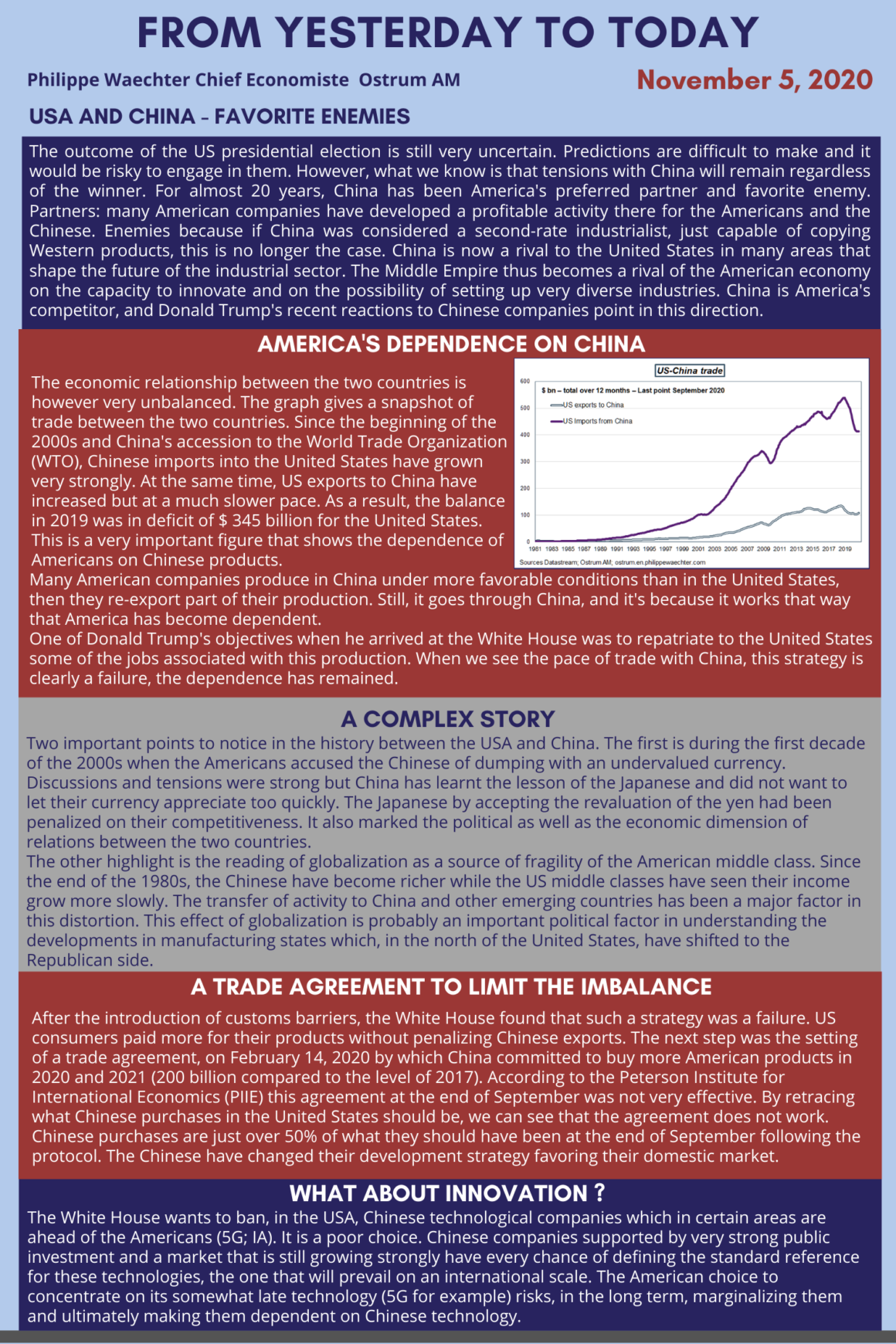Donald Trump’s mandate was marked by his battle with China. The Middle Empire is shaking up America economically, technologically and politically. These tensions are not recent but have increased with the arrival of Donald Trump to the White House. The next president, whether Republican or Democrat, will not question this best enemy. The United States is being pushed around and all are reacting in a coherent but not always effective way to maintain American preeminence.
The outcome of the US presidential election is still very uncertain. Predictions are difficult to make and it would be risky to engage in them. However, what we know is that tensions with China will remain regardless of the winner. For almost 20 years, China has been America’s preferred partner and favorite enemy. Partners: many American companies have developed a profitable activity there for the Americans and the Chinese. Enemies because if China was considered a second-rate industrialist, just capable of copying Western products, this is no longer the case. China is now a rival to the United States in many areas that shape the future of the industrial sector. The Middle Empire thus becomes a rival of the American economy on the capacity to innovate and on the possibility of setting up very diverse industries. China is America’s competitor, and Donald Trump’s recent reactions to Chinese companies point in this direction.
America’s dependence on China

The economic relationship between the two countries is however very unbalanced. The graph gives a snapshot of trade between the two countries. Since the beginning of the 2000s and China’s accession to the World Trade Organization (WTO), Chinese imports into the United States have grown very strongly. At the same time, US exports to China have increased but at a much slower pace. As a result, the balance in 2019 was in deficit of $ 345 billion for the United States. This is a very important figure that shows the dependence of Americans on Chinese products.
Many American companies produce in China under more favorable conditions than in the United States, then they re-export part of their production. Still, it goes through China, and it’s because it works that way that America has become dependent.
One of Donald Trump’s objectives when he arrived at the White House was to repatriate to the United States some of the jobs associated with this production. When we see the pace of trade with China, this strategy is clearly a failure, the dependence has remained.
A Complex Story
Two important points to notice in the history between the USA and China. The first is during the first decade of the 2000s when the Americans accused the Chinese of dumping with an undervalued currency. Discussions and tensions were strong but China has learnt the lesson of the Japanese and did not want to let their currency appreciate too quickly. The Japanese by accepting the revaluation of the yen had been penalized on their competitiveness. It also marked the political as well as the economic dimension of relations between the two countries.
The other highlight is the reading of globalization as a source of fragility of the American middle class. Since the end of the 1980s, the Chinese have become richer while the US middle classes have seen their income grow more slowly. The transfer of activity to China and other emerging countries has been a major factor in this distortion. This effect of globalization is probably an important political factor in understanding the developments in manufacturing states which, in the north of the United States, have shifted to the Republican side.
A Trade Agreement to limit the imbalance
After the introduction of customs barriers, the White House found that such a strategy was a failure. US consumers paid more for their products without penalizing Chinese exports. The next step was the setting of a trade agreement, on February 14, 2020 by which China committed to buy more American products in 2020 and 2021 (200 billion compared to the level of 2017). According to the Peterson Institute for International Economics (PIIE) this agreement at the end of September was not very effective. By retracing what Chinese purchases in the United States should be, we can see that the agreement does not work. Chinese purchases are just over 50% of what they should have been at the end of September following the protocol. The Chinese have changed their development strategy favoring their domestic market.
What about innovation ?
The White House wants to ban, in the USA, Chinese technological companies which in certain areas are ahead of the Americans (5G; IA). It is a poor choice. Chinese companies supported by very strong public investment and a market that is still growing strongly have every chance of defining the standard reference for these technologies, the one that will prevail on an international scale. The American choice to concentrate on its somewhat late technology (5G for example) risks, in the long term, marginalizing them and ultimately making them dependent on Chinese technology.
___________________________________________________________
The infographic of this post is downloadable



